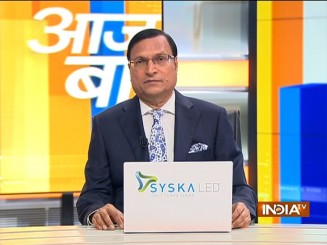 The ‘hijab’ controversy has now reached the Karnataka High Court and Supreme Court, but, on the other hand, some Muslim organizations have already started staging protest demonstrations in different cities, including Delhi and Aligarh. This is surely a matter of concern.
The ‘hijab’ controversy has now reached the Karnataka High Court and Supreme Court, but, on the other hand, some Muslim organizations have already started staging protest demonstrations in different cities, including Delhi and Aligarh. This is surely a matter of concern.
On Thursday, a three-judge bench of Karnataka High Court gave an interim order saying no religious clothes should be worn by students in schools and colleges. The high court asked the state government to immediately reopen all educational institutions, and posted the matter for further hearing on Monday. The Karnataka government immediately ordered reopening of all schools for classes 9 and 10 from Monday, but pre-university and degree colleges will remain closed until further notice.
Meanwhile, Asaduddin Owaisi’s All India Majlis-e-Ittehadul Muslimeen staged protest in Delhi’s Shaheen Bagh locality. The protesters marched from Abul Fazal Enclave to Shahid Bilal Mosque shouting ‘Allahu Akbar’ slogans. Ultra-leftist All India Students Association (AISA) also held a protest outside Karnataka Bhavan in Delhi, but were prevented by police from moving forward. A similar protest took place in Aligarh Muslim University campus.
A Jamia Millia Islamia student Asif Iqbal Tanha posted provocative posts on social media on Thursday, setting Twitter abuzz with the trend ‘Allahu Akbar’. In a Space audio, the student posted his image and appealed to all Muslims in Delhi to come forward to stage protests over the ‘hijab’ issue. He alleged that the identity and fundamental rights of minorities are being challenged, and it should be resisted. He also mentioned how Students Islamic Organization (SIO) was mobilizing Muslim youths in Karnataka. He called on youths to stand in solidarity with the Muslim girl who raised ‘Allahu Akbar’ slogan in front of a mob of people wearing saffron scarves.
For the sake of my readers, I will now try to elaborate what the ‘hijab’ controversy is all about.
‘Hijab’ means a headscarf meant to cover the hair and neck, but not the face. ‘Niqab’ is a cover or veil meant to cover the head and face, but not the eyes. It accompanies an ‘abaya’, a loose black garment that covers the woman from head to feet. ‘Burqa’ commonly worn by Indian Muslim women, covers the entire body and face, with a mesh window or grille for eyesight. ‘Chador’ is a full length cloth worm by many Iranian women, while ‘Dupatta’ is a long scarf loosely draped over the head and shoulders, commonly worn by Indian women, both Hindu and Muslim.
Now, a look at many countries across the world, where governments have made it an offence if any woman wears a ‘hijab’ or ‘burqa’ or ‘abaya’.
Last year, Switzerland, with a 51.2 per cent of voters’ backing, banned wearing of full face coverings in public places. In The Netherlands, since August, 2019, there is ban on wearing of burqas, veils and balaclavas, with a 150 euros fine. The ban was imposed after 14 years of debate. Since 2011, France has banned wearing of all face coverings, that include headgear, helmets, balaclavas, niqabs. The ban also includes burqa if it covers the face.
In Sri Lanka, the cabinet has cleared a proposal to ban wearing of face coverings in public places due to ‘national security concerns’, but the proposal is yet to be implemented. Belgium has banned wearing of full face coverings, including burqa, since 2011. However, last year, wearing of hijab was permitted in universities in a French-speaking region in Belgium.
China has clamped a complete ban on wearing of veils and burqas, including abnormal beard, in Muslim-dominated Xinjiang since 2017 citing threats from ‘religious extremism’. In Denmark, there is a ban on wearing of burqas since 2018, with a fine of 135 Euros. In Austria, there is a law since 2017 against wearing of veils. It bans covering from hairline till chins, and offenders will have to pay 150 Euros for committing offence. In Bulgaria, the ban is in force since 2016 against covering of faces in public, but it allows wearing of veils in place of worship.
In July last year, the European Union’s highest court upheld a 2017 ruling allowing employers to forbid women from wearing headscarves at work places. Two provinces in Germany have also banned wearing of veils or niqab in public places and schools. Norway has banned wearing of niqab or hijab by students or teachers in schools since 2018. In Stavropol region of Russia, there is a ban on wearing of hijab in public places.
In some regions of Kazakhstan, wearing of hijab, niqab and headscarves have been banned in schools and also in public. There is a ban on sale of religious face coverings in Uzbekistan since 2012, and the imam of a mosque was sacked when he appealed to the President to lift the ban on hijab for women and beards for men. Canada banned wearing of face veils including niqab in 2011, for all those women, who have taken Canadian citizenship oaths, but this order was later reversed by a court in 2016.
I have mentioned all these facts in order to put the entire controversy in perspective. I personally feel that we should all wait for the final judgement from Karnataka High Court, or from the Supreme Court. This issue is related to education of Muslim girls, and is also related to the autonomy of educational institutions. Therefore, we must all refrain from creating unnecessary tension and wait for the courts to give the judgement.